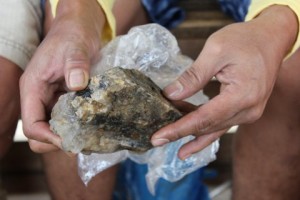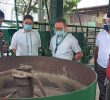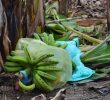
PRECIOUS ROCK. Rocks that contain gold ores such as this are abundant in the mountains of Davao region. (davaotoday.com photo by Medel V. Hernani)
With the number of mining firms under exploration concessions, gold, nickel and copper in the rocky mountains of Davao region continue to be up for grabs. But government earnings from the excise taxes paid by mining firms are small.
By MARILOU AGUIRRE-TUBURAN
Davao Today
DAVAO CITY, Philippines — Anytime now, Malacañang will unveil its new mining policy, with a draft executive order aiming to increase taxes on mining firms and review existing contracts.
As Mindanao businessmen were quick to criticize the move saying this would hurt business, and Presidential spokesperson issuing a statement to allay these fears, just what is at stake for mining in the Davao region?
With the number of mining firms under exploration concessions, gold, nickel and copper in the mountains of Davao region continue to be up for grabs. But government earnings from the excise taxes paid by mining firms are small.
Apex Mining, one of only two mining firms in full operation in the region, contributed to government coffers only PHP 18.7 million (USD 0.44 million), in the first half of last year. The other firm, Holcim cement, was taxed even lesser, at PHP 1.2 million (USD 0.028 million) covering the same period.
Apex Mining has been mining the mountains of Maco town, Compostela Valley since the 1970s. It first ventured in copper mining but shifted to gold in the mid to late ‘70s when the prices of copper were decreasing while gold prices were soaring. In 2008, it was registered with the Board of Investments as a new producer of gold, silver bullion and copper concentrates with gold, silver, zinc and lead values on a non-pioneer status. All of its production is smelted in Switzerland.
In the first half of 2011, the company produced 424 Kilograms (Kg) of gold amounting to PHP 857,261,869 (USD 20,121,900) with an excise tax of PHP 16,524,917.21 (USD 387,878) or only 1.09 percent of the total amount. It produced 2,336.2o Kg of silver amounting to PHP 117,904,463 (USD 2,767,490) with an excise tax of PHP 2,231,050.15 (USD 52,367.9) or only 1.89 percent of the total amount.
Meanwhile, Holcim started in a tiny village of Holderbank, Canton Aargau in Switzerland in 1912. From the name Holderbank Financiere Glaris Limited, it changed its name to Holcim in 2001. It operates in more than 70 countries in the world supplying cement, crushed stone, sand and gravel, ready-mix concrete and asphalt. Its entry in the region more than a decade ago forced the closure of Hi Cement Corporation, Union Cement Corporation and Bacnotan Cement Corporation.
In Davao region, Holcim operates in Ilang village, this city and in Dawan, Davao Oriental. Its plant is capable of producing more than 1,500,000 bags of cement annually. Its quarry in Bunawan village is currently producing limestone and it has ship loading facility in its own wharf at Ilang village.
In 2011, Holcim produced 881,499.43 metric tons of limestone (a component of cement). It produced 17,183,730 bags of cement last year of which 12,589,620 were sold to the local market while 592,700 were sold to foreign markets such as Madrid, Palau, Singapore and Holland.
In the research presented by Maita Gomez of Bantay Kita during an International conference on mining held last month, the average share of mining industry to Davao region’s gross domestic regional product from 2001 to 2009 is only 3.97 percent while its average share to the country’s Gross Domestic Product is only 0.91 percent.
Davao City produces lime, limestone, earthfill, sand and gravel. Compostela Valley province produces gold, silver, lead-zinc ore, magnetite sand, limestone, silica, copper tailings, sand and gravel. Davao del Norte produces earthfill, sand and gravel. Davao Oriental produces ores of chromite, copper and manganese, as well as magnesite, pebbles, sand and gravel. And Davao del Sur produces earthfill, boulders, sand and gravel.
Based on the documents furnished by Mines and Geosciences Bureau to davaotoday.com, companies have been granted exploration permit (EP) and Mineral Production Sharing Agreement (MPSA).
In Davao del Sur, the Sagittarius Mines, Incorporated (Inc.) obtained an EP for gold, copper and silver in Kiblawan in 2008-2009 covering 9,597 hectares. In Davao del Norte, Holcim had an MPSA for limestone in Panabo City since 2002 to 2027 covering 5,248 hectares. In Davao City, Holcim has three MPSA for limestone which started as early as 1997 and ends as late as 2033 covering a total of 6,547 hectares. It also had an MPSA for shale covering 148 hectares.
In Compostela Valley province, Alsons Development (Devt.) and Investment Corporation (Corp.) has an MPSA for gold and copper in Manat, Nabunturan town. It started in 1997 and will end in 2022 covering 1,547 hectares. King Eagle Exploration and Mining Corp. has an MPSA for gold and silver in Boringot, Pantukan town in 2002-2007 covering 324 hectares. Nationwide Dev’t. Corp. has an MPSA for gold and silver in Pantukan town since 1992 to 2017 covering 1,656 hectares. Napnapan Mineral Resources, Inc. has an MPSA for gold, copper and silver in Pantukan town since 2010 to 2035 covering 4,921 hectares.
In Davao Oriental, among the firms include the Oro East Mining Corp., Inc. which has an MPSA for gold, among others, in the towns of Mati and Lupon since 2010 to 2035 covering 7,798 hectares. The Dabawenyo Mineral Corporation has an MPSA for molybdenum ore in the towns of Mati and Lupon since 2007 to 2031 covering 6,917 hectares. The same is true for the Phil. Youbang Mining International Corporation. Holcim has two MPSA for silica in Mati town which started as early as 1997 and will end as late as 2034 covering 166 hectares and 255 hectares, respectively. Patrick Mining and Devt. Corp. has an MPSA for nickel in Mati town since 2004 to 2029 covering 2,289 hectares. Galactica Mining and Devt. Corp. has an MPSA for nickel in the towns of Mati and San Isidro since 2005 to 2030 covering 2.337 hectares. (Marilou Aguirre-Tuburan/davaotoday.com










